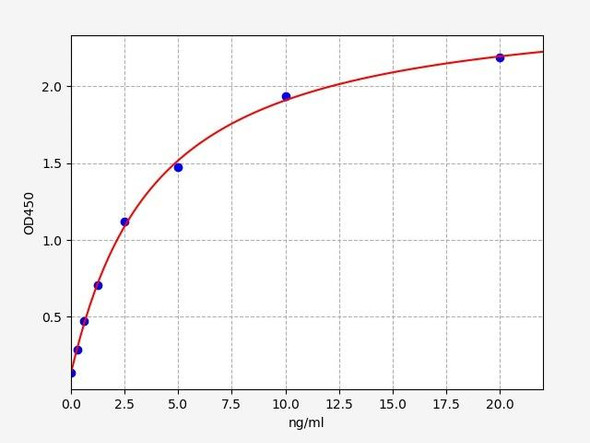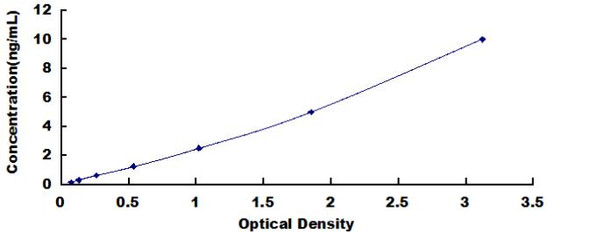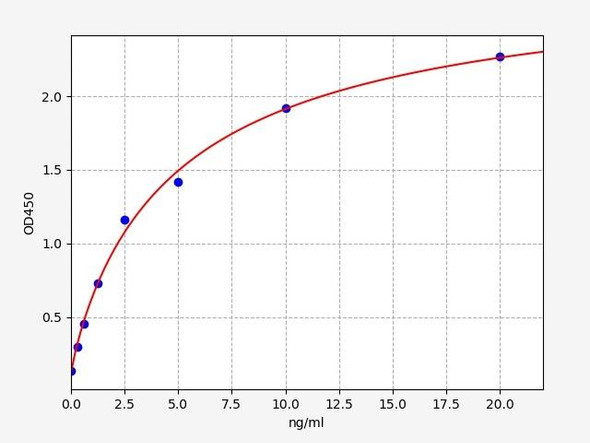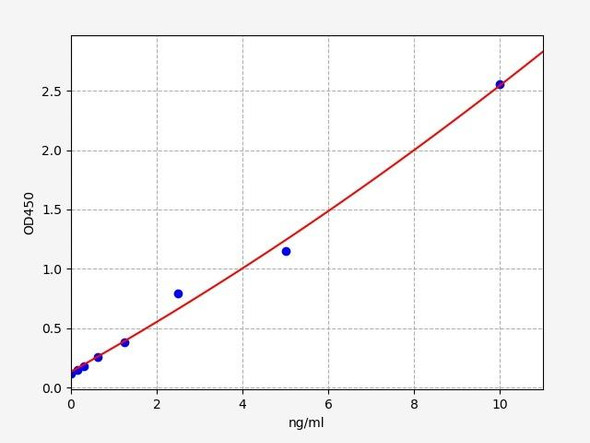Description
Human G-protein coupled estrogen receptor 1 (GPER) ELISA Kit
The Human GPER (G-Protein Coupled Estrogen Receptor 1) ELISA Kit is a valuable tool for the precise measurement of GPER levels in human serum, plasma, and cell culture supernatants. With superior sensitivity and specificity, this kit delivers accurate and consistent results, making it suitable for a variety of research applications.GPER is a key receptor involved in mediating the effects of estrogen signaling in various tissues, including the cardiovascular system, reproductive organs, and the central nervous system.
Dysregulation of GPER has been linked to several diseases, such as breast cancer, cardiovascular disorders, and Alzheimer's disease, highlighting its significance as a potential therapeutic target and biomarker.This ELISA kit provides researchers with a reliable method for quantifying GPER levels, enabling further exploration of its role in disease pathogenesis and the development of novel treatment strategies. Trust in the Human GPER ELISA Kit for precise and accurate measurement of GPER levels in human samples.
| Product Name: | Human G-protein coupled estrogen receptor 1 (GPER) ELISA Kit |
| SKU: | HUEB1232 |
| Size: | 96T |
| Target: | Human G-protein coupled estrogen receptor 1 (GPER) |
| Synonyms: | Chemoattractant receptor-like 2, Flow-induced endothelial G-protein coupled receptor 1, G protein-coupled estrogen receptor 1, G-protein coupled receptor 30, GPCR-Br, IL8-related receptor DRY12, Lymphocyte-derived G-protein coupled receptor, Membrane estrogen receptor, FEG-1, LYGPR, mER, CEPR, CMKRL2, DRY12, GPER, GPR30 |
| Assay Type: | Sandwich |
| Detection Method: | ELISA |
| Reactivity: | Human |
| Detection Range: | 0.312-20ng/mL |
| Sensitivity: | 0.127ng/mL |
| Intra CV: | 4.6% | ||||||||||||||||||||
| Inter CV: | 7.6% | ||||||||||||||||||||
| Linearity: |
| ||||||||||||||||||||
| Recovery: |
| ||||||||||||||||||||
| Function: | G-protein coupled estrogen receptor that binds to 17-beta-estradiol (E2) with high affinity, leading to rapid and transient activation of numerous intracellular signaling pathways. Stimulates cAMP production, calcium mobilization and tyrosine kinase Src inducing the release of heparin-bound epidermal growth factor (HB-EGF) and subsequent transactivation of the epidermal growth factor receptor (EGFR), activating downstream signaling pathways such as PI3K/Akt and ERK/MAPK. Mediates pleiotropic functions among others in the cardiovascular, endocrine, reproductive, immune and central nervous systems. Has a role in cardioprotection by reducing cardiac hypertrophy and perivascular fibrosis in a RAMP3-dependent manner. Regulates arterial blood pressure by stimulating vasodilation and reducing vascular smooth muscle and microvascular endothelial cell proliferation. Plays a role in blood glucose homeostasis contributing to the insulin secretion response by pancreatic beta cells. Triggers mitochondrial apoptosis during pachytene spermatocyte differentiation. Stimulates uterine epithelial cell proliferation. Enhances uterine contractility in response to oxytocin. Contributes to thymic atrophy by inducing apoptosis. Attenuates TNF-mediated endothelial expression of leukocyte adhesion molecules. Promotes neuritogenesis in developing hippocampal neurons. Plays a role in acute neuroprotection against NMDA-induced excitotoxic neuronal death. Increases firing activity and intracellular calcium oscillations in luteinizing hormone-releasing hormone (LHRH) neurons. Inhibits early osteoblast proliferation at growth plate during skeletal development. Inhibits mature adipocyte differentiation and lipid accumulation. Involved in the recruitment of beta-arrestin 2 ARRB2 at the plasma membrane in epithelial cells. Functions also as a receptor for aldosterone mediating rapid regulation of vascular contractibility through the PI3K/ERK signaling pathway. Involved in cancer progression regulation. Stimulates cancer-associated fibroblast (CAF) proliferation by a rapid genomic response through the EGFR/ERK transduction pathway. Associated with EGFR, may act as a transcription factor activating growth regulatory genes (c-fos, cyclin D1). Promotes integrin alpha-5/beta-1 and fibronectin (FN) matrix assembly in breast cancer cells. |
| Uniprot: | Q99527 |
| Sample Type: | Serum, plasma, tissue homogenates, cell culture supernates and other biological fluids |
| Specificity: | Natural and recombinant human G-protein coupled estrogen receptor 1 |
| Sub Unit: | Homodimer (Probable). Heterodimer; heterodimerizes with other G-protein-coupled receptor (GPCRs) like CRHR1, HTR1A and PAQR8. Interacts (via C-terminus tail motif) with DLG4 (via N-terminus tandem pair of PDZ domains); the interaction is direct and induces the increase of GPER1 protein levels residing at the plasma membrane surface in a estradiol-independent manner (By similarity). Interacts with RAMP3. Interacts with KRT7 and KRT8. Interacts with EGFR; the interaction increases after agonist-induced stimulation in cancer-associated fibroblasts (CAF). Interacts with EGFR and ESR1. |
| Research Area: | Metabolism |
| Subcellular Location: | Nucleus Cytoplasm Cytoplasm Perinuclear region Cytoplasm Cytoskeleton Cell membrane Multi-pass membrane protein Basolateral cell membrane Multi-pass membrane protein Cytoplasmic vesicle membrane Multi-pass membrane protein Early endosome Recycling endosome Golgi apparatus membrane Multi-pass membrane protein Golgi apparatus Trans-Golgi network Endoplasmic reticulum membrane Multi-pass membrane protein Cell projection Dendrite Cell projection Dendritic spine membrane Multi-pass membrane protein Cell projection Axon Cell junction Synapse Postsynaptic cell membrane Postsynaptic density Mitochondrion membrane Multi-pass membrane protein Colocalized with BSN to the active zone of presynaptic density. Colocalized with DLG4/PSD95 and neurabin-2 PPP1R9B in neuronal synaptosomes (By similarity). Endocytosed in a agonist- and arrestin-independent manner. Colocalized with RAMP3 and clathrin-coated pits at the plasma membrane. Colocalized with transferrin receptor at the plasma membrane and perinuclear region. Accumulated and colocalized with RAB11 proteins in recycling endosomes and trans-Golgi network (TGN), but does neither recycle back to the cell surface nor traffics to late endosome or lysosome. Colocalized with calnexin in the endoplasmic reticulum. Traffics to intracellular sites via cytokeratin intermediate filaments like KRT7 and KRT8 after constitutive endocytosis in epithelial cells. Colocalized with EGFR in the nucleus of agonist-induced cancer-associated fibroblasts (CAF). |
| Storage: | Please see kit components below for exact storage details |
| Note: | For research use only |
| UniProt Protein Function: | GPER1: Receptor for estrogen. Belongs to the G-protein coupled receptor 1 family. |
| UniProt Protein Details: | Protein type:Membrane protein, integral; Motility/polarity/chemotaxis; Membrane protein, multi-pass; Receptor, GPCR; GPCR, family 1 Chromosomal Location of Human Ortholog: 7p22.3 Cellular Component: Golgi apparatus; integral to plasma membrane; early endosome; dendrite; nuclear envelope; trans-Golgi network; recycling endosome; perinuclear region of cytoplasm; cytoplasm; keratin filament; intracellular; dendritic shaft; endoplasmic reticulum membrane; cytoplasmic vesicle membrane; endoplasmic reticulum; postsynaptic density; Golgi membrane; presynaptic membrane; axon; mitochondrial membrane; presynaptic active zone; plasma membrane; nerve terminal; nucleus; cell junction Molecular Function:G-protein coupled receptor activity; protein binding; estrogen receptor activity; chromatin binding; mineralocorticoid receptor activity; steroid binding Biological Process: positive regulation of apoptosis; generation of action potential; positive regulation of caspase activity; nuclear fragmentation during apoptosis; negative regulation of DNA metabolic process; positive regulation of vasodilation; positive regulation of neurotransmitter secretion; negative regulation of leukocyte activation; negative regulation of cell proliferation; elevation of cytosolic calcium ion concentration; positive regulation of MAPKKK cascade; positive regulation of epidermal growth factor receptor signaling pathway; positive regulation of cAMP biosynthetic process; positive regulation of cell proliferation; inflammatory response; steroid hormone receptor signaling pathway; positive regulation of neurogenesis; cytosolic calcium ion homeostasis; negative regulation of lipid biosynthetic process; positive regulation of insulin secretion; positive regulation of inositol trisphosphate biosynthetic process; cell cycle; negative regulation of fat cell differentiation; apoptotic chromosome condensation; positive regulation of phosphoinositide 3-kinase cascade; G-protein coupled receptor protein signaling pathway; mineralocorticoid receptor signaling pathway; negative regulation of inflammatory response; positive regulation of G-protein coupled receptor protein signaling pathway; innate immune response; positive regulation of transcription from RNA polymerase II promoter; steroid hormone mediated signaling; positive regulation of protein amino acid phosphorylation; positive regulation of release of sequestered calcium ion into cytosol; positive regulation of cell migration |
| NCBI Summary: | This gene is a member of the G-protein coupled receptor 1 family and encodes a multi-pass membrane protein that localizes to the endoplasmic reticulum. The protein binds estrogen, resulting in intracellular calcium mobilization and synthesis of phosphatidylinositol 3,4,5-trisphosphate in the nucleus. This protein therefore plays a role in the rapid nongenomic signaling events widely observed following stimulation of cells and tissues with estrogen. Alternate transcriptional splice variants which encode the same protein have been characterized. [provided by RefSeq, Jul 2008] |
| UniProt Code: | Q99527 |
| NCBI GenInfo Identifier: | 3023539 |
| NCBI Gene ID: | 2852 |
| NCBI Accession: | Q99527.1 |
| UniProt Secondary Accession: | Q99527,Q8BMP4, O08878, |
| UniProt Related Accession: | Q99527 |
| Molecular Weight: | 42,248 Da |
| NCBI Full Name: | G-protein coupled estrogen receptor 1 |
| NCBI Synonym Full Names: | G protein-coupled estrogen receptor 1 |
| NCBI Official Symbol: | GPER1 |
| NCBI Official Synonym Symbols: | mER; CEPR; GPER; DRY12; FEG-1; GPR30; LERGU; LyGPR; CMKRL2; LERGU2; GPCR-Br |
| NCBI Protein Information: | G-protein coupled estrogen receptor 1; heptahelix receptor; chemokine receptor-like 2; IL8-related receptor DRY12; membrane estrogen receptor; G protein-coupled receptor 30; chemoattractant receptor-like 2; leucine rich protein in GPR30 3'UTR; lymphocyte- |
| UniProt Protein Name: | G-protein coupled estrogen receptor 1 |
| UniProt Synonym Protein Names: | Chemoattractant receptor-like 2; Flow-induced endothelial G-protein coupled receptor 1; FEG-1; G protein-coupled estrogen receptor 1; G-protein coupled receptor 30; GPCR-Br; IL8-related receptor DRY12; Lymphocyte-derived G-protein coupled receptor; LYGPR; Membrane estrogen receptor; mER |
| UniProt Gene Name: | GPER1 |
| UniProt Entry Name: | GPER1_HUMAN |
| Component | Quantity (96 Assays) | Storage |
| ELISA Microplate (Dismountable) | 8×12 strips | -20°C |
| Lyophilized Standard | 2 | -20°C |
| Sample Diluent | 20ml | -20°C |
| Assay Diluent A | 10mL | -20°C |
| Assay Diluent B | 10mL | -20°C |
| Detection Reagent A | 120µL | -20°C |
| Detection Reagent B | 120µL | -20°C |
| Wash Buffer | 30mL | 4°C |
| Substrate | 10mL | 4°C |
| Stop Solution | 10mL | 4°C |
| Plate Sealer | 5 | - |
Other materials and equipment required:
- Microplate reader with 450 nm wavelength filter
- Multichannel Pipette, Pipette, microcentrifuge tubes and disposable pipette tips
- Incubator
- Deionized or distilled water
- Absorbent paper
- Buffer resevoir
*Note: The below protocol is a sample protocol. Protocols are specific to each batch/lot. For the correct instructions please follow the protocol included in your kit.
Allow all reagents to reach room temperature (Please do not dissolve the reagents at 37°C directly). All the reagents should be mixed thoroughly by gently swirling before pipetting. Avoid foaming. Keep appropriate numbers of strips for 1 experiment and remove extra strips from microtiter plate. Removed strips should be resealed and stored at -20°C until the kits expiry date. Prepare all reagents, working standards and samples as directed in the previous sections. Please predict the concentration before assaying. If values for these are not within the range of the standard curve, users must determine the optimal sample dilutions for their experiments. We recommend running all samples in duplicate.
| Step | |
| 1. | Add Sample: Add 100µL of Standard, Blank, or Sample per well. The blank well is added with Sample diluent. Solutions are added to the bottom of micro ELISA plate well, avoid inside wall touching and foaming as possible. Mix it gently. Cover the plate with sealer we provided. Incubate for 120 minutes at 37°C. |
| 2. | Remove the liquid from each well, don't wash. Add 100µL of Detection Reagent A working solution to each well. Cover with the Plate sealer. Gently tap the plate to ensure thorough mixing. Incubate for 1 hour at 37°C. Note: if Detection Reagent A appears cloudy warm to room temperature until solution is uniform. |
| 3. | Aspirate each well and wash, repeating the process three times. Wash by filling each well with Wash Buffer (approximately 400µL) (a squirt bottle, multi-channel pipette,manifold dispenser or automated washer are needed). Complete removal of liquid at each step is essential. After the last wash, completely remove remaining Wash Buffer by aspirating or decanting. Invert the plate and pat it against thick clean absorbent paper. |
| 4. | Add 100µL of Detection Reagent B working solution to each well. Cover with the Plate sealer. Incubate for 60 minutes at 37°C. |
| 5. | Repeat the wash process for five times as conducted in step 3. |
| 6. | Add 90µL of Substrate Solution to each well. Cover with a new Plate sealer and incubate for 10-20 minutes at 37°C. Protect the plate from light. The reaction time can be shortened or extended according to the actual color change, but this should not exceed more than 30 minutes. When apparent gradient appears in standard wells, user should terminatethe reaction. |
| 7. | Add 50µL of Stop Solution to each well. If color change does not appear uniform, gently tap the plate to ensure thorough mixing. |
| 8. | Determine the optical density (OD value) of each well at once, using a micro-plate reader set to 450 nm. User should open the micro-plate reader in advance, preheat the instrument, and set the testing parameters. |
| 9. | After experiment, store all reagents according to the specified storage temperature respectively until their expiry. |
When carrying out an ELISA assay it is important to prepare your samples in order to achieve the best possible results. Below we have a list of procedures for the preparation of samples for different sample types.
| Sample Type | Protocol |
| Serum | If using serum separator tubes, allow samples to clot for 30 minutes at room temperature. Centrifuge for 10 minutes at 1,000x g. Collect the serum fraction and assay promptly or aliquot and store the samples at -80°C. Avoid multiple freeze-thaw cycles. If serum separator tubes are not being used, allow samples to clot overnight at 2-8°C. Centrifuge for 10 minutes at 1,000x g. Remove serum and assay promptly or aliquot and store the samples at -80°C. Avoid multiple freeze-thaw cycles. |
| Plasma | Collect plasma using EDTA or heparin as an anticoagulant. Centrifuge samples at 4°C for 15 mins at 1000 × g within 30 mins of collection. Collect the plasma fraction and assay promptly or aliquot and store the samples at -80°C. Avoid multiple freeze-thaw cycles. Note: Over haemolysed samples are not suitable for use with this kit. |
| Urine & Cerebrospinal Fluid | Collect the urine (mid-stream) in a sterile container, centrifuge for 20 mins at 2000-3000 rpm. Remove supernatant and assay immediately. If any precipitation is detected, repeat the centrifugation step. A similar protocol can be used for cerebrospinal fluid. |
| Cell culture supernatant | Collect the cell culture media by pipette, followed by centrifugation at 4°C for 20 mins at 1500 rpm. Collect the clear supernatant and assay immediately. |
| Cell lysates | Solubilize cells in lysis buffer and allow to sit on ice for 30 minutes. Centrifuge tubes at 14,000 x g for 5 minutes to remove insoluble material. Aliquot the supernatant into a new tube and discard the remaining whole cell extract. Quantify total protein concentration using a total protein assay. Assay immediately or aliquot and store at ≤ -20 °C. |
| Tissue homogenates | The preparation of tissue homogenates will vary depending upon tissue type. Rinse tissue with 1X PBS to remove excess blood & homogenize in 20ml of 1X PBS (including protease inhibitors) and store overnight at ≤ -20°C. Two freeze-thaw cycles are required to break the cell membranes. To further disrupt the cell membranes you can sonicate the samples. Centrifuge homogenates for 5 mins at 5000xg. Remove the supernatant and assay immediately or aliquot and store at -20°C or -80°C. |
| Tissue lysates | Rinse tissue with PBS, cut into 1-2 mm pieces, and homogenize with a tissue homogenizer in PBS. Add an equal volume of RIPA buffer containing protease inhibitors and lyse tissues at room temperature for 30 minutes with gentle agitation. Centrifuge to remove debris. Quantify total protein concentration using a total protein assay. Assay immediately or aliquot and store at ≤ -20 °C. |
| Breast Milk | Collect milk samples and centrifuge at 10,000 x g for 60 min at 4°C. Aliquot the supernatant and assay. For long term use, store samples at -80°C. Minimize freeze/thaw cycles. |








